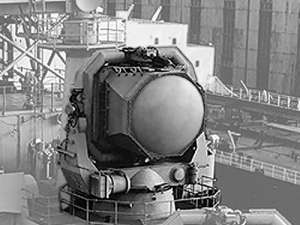AN/SPG-49
Description of the radar set, tactical-technical characteristics

Figure 1: AN/SPG-49
(cropped from pic of www.navysite.de)
| Specifications | |
|---|---|
| frequency: | 5 400 … 5 900 MHz
( C-Band) |
| pulse repetition time (PRT): | |
| pulse repetition frequency (PRF): | |
| pulsewidth (τ): | |
| receive time: | |
| dead time: | |
| peak power: | 3 MW |
| average power: | |
| instrumented range: | 150 NM (≙ 275 km) |
| range resolution: | 150 ft |
| accuracy: | 0.025%; 0.25 mil |
| beamwidth: | 1.8° |
| hits per scan: | |
| antenna rotation: | |
| MTBCF: | 30 hrs |
| MTTR: | |
AN/SPG-49
The AN/SPG-49 was an operating in C-band fire control radar for the U.S. Navy's RIM-8 Talos shipboard air defense systems. It used a three-gimbal system – azimuth, elevation, and traverse – which allowed scanning and tracking throughout the hemisphere. The AN/SPG-49 combined a monopulse tracking radar and a continuous wave illumination radar into the one antenna. The radar transmitters power for the aquisition and tracking radar was generated by a liquid cooled klystron and were located inside the antenna itself.
The AN/SPG-49 performed three functions. During target acquisition the antenna radiated 3 MW pulsed bearing and azimuth sweeps to determine range, bearing and altitude of a target. The antenna consists of a Foster Scanner feeding a folded reflector and utilizes a lens aperture with an overall diameter of 110 inch and a fiberglass radome. After the target had been acquired the antenna switched to a pulsed 3 MW narrow beam tracking radar using a monopulse horn. When a missile closed range to a target the antenna also radiated a 5 kW continuous wave illumination beam that carried target identification information for the missile to home on.
The AN/SPG-49 was designed in 1947, and became obsolete with Talos at the end of 1979.
Sources and ressorces:
- Nicholas J. Willis, Hugh Griffiths: ''Advances in Bistatic Radar'' SciTech Publishing, 2007, ISBN 9781891121487 S.99 (online preview)
- Phillip R. Hays' home page
